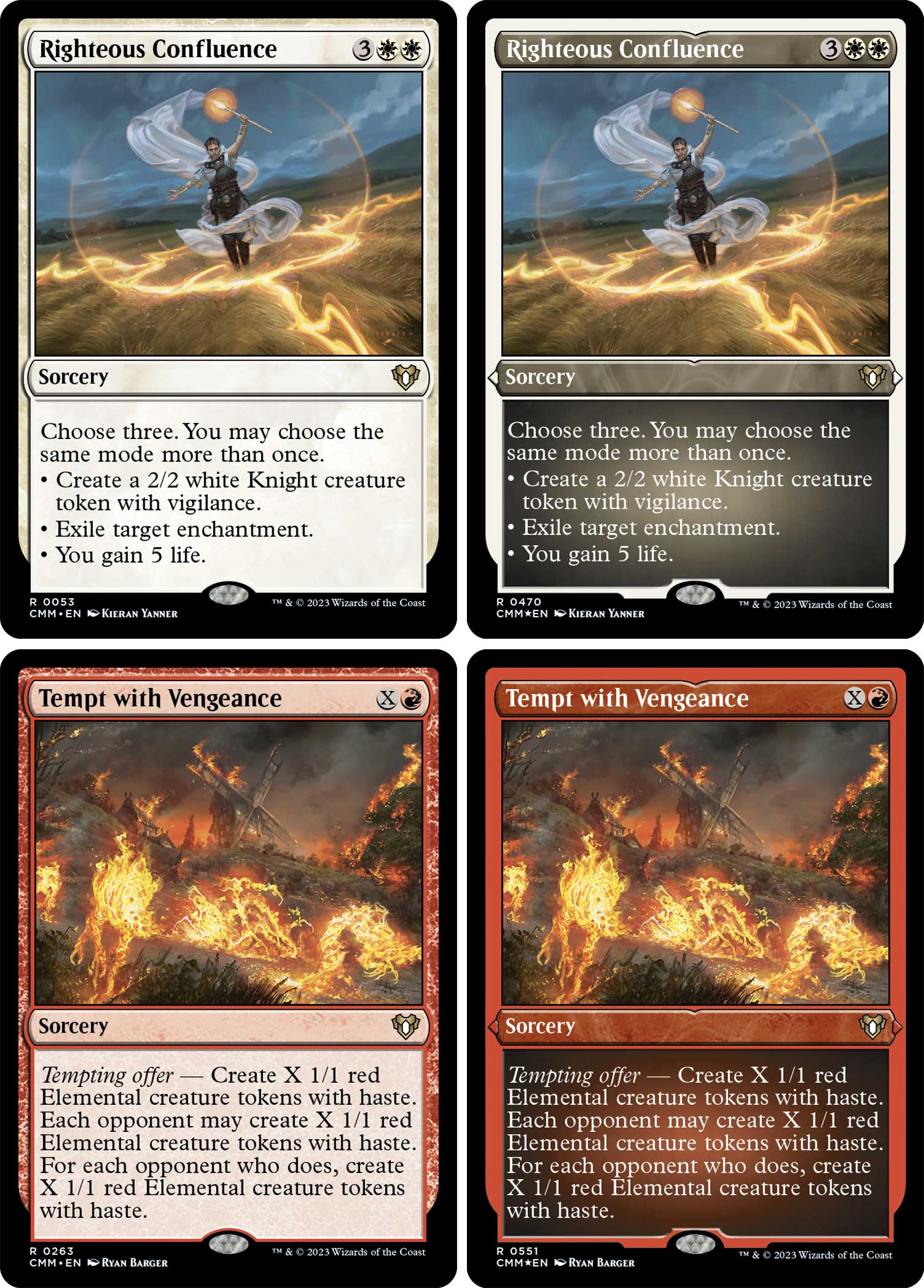Commander Masters preview season is going full steam ahead and that includes the two free previews given to the team here at Hipsters of the Coast courtesy of Wizards of the Coast. One of the cards hasn’t seen a reprint since its original printing in Commander 2013, while the other is a utility card that has made it into a lot of second drafts of my decks once I identify the cards I’m just not using.
Needless to say, I’m very honored to bring you these Commander Masters previews:

Righteous Confluence is a card that is often slept on that I would recommend giving a second look. As we’ve seen the proliferation of enchantment creatures—especially indestructible gods—the ability to exile several enchantments at once has proven to be more important than I would have expected. Additionally, while life gain in itself is generally not worth a card, regaining five or 10 life on top of removal or a creature token can be a good stabilizing action.
And then there is Tempt with Vengeance. The fact that this card hasn’t been printed in 10 (!) years, while being a staple in Purphoros, God of the Forge and Gahiji, Honored One decks is surprising. While playing the card can read as only slightly asymmetrical, building with it in mind can make it an easy finisher. And even if you’ve never had the chance to cast a Tempting Offer, know that you haven’t lived until you’ve cast a Gather Specimens against an opposing Tempt with Vengeance.
After some reflection, I believe that both of these cards are examples of Wizards’ attempts to better understand and design for multiplayer formats. It made me look at the choices being made by these cards, by the caster and their opponents. From that curiosity grew this brief overview of the lineages that lead to both of these cards within the history of Magic’s design.

The Choices We’re Given
In the beginning, Mirage and Visions codified charms through the cycle of 10. The adoption of card designs in this mold was simple technology, but a boon for the overall growth of Magic card design. Whereas Ice Age’s designers had tried to balance mana value by adding cantrips, the Mirage design team took two effects that may not have been seen worth a single card and merged them for better card selection.
While modal spell designs would have dozens of iterations including Entwine, the notable evolution was the Commands in Lorwyn. Now, instead of choosing one of two options, we were choosing two of four. These larger impact spells were fitting for the multiplayer format, encompassing several high curve effects in a single card. And consistently, Austere Command remains the member of the cycle I would most expect to see in a game of Commander.
With popularity of the original Lorwyn command cycle, it would only make sense that Wizards would want to build upon those successes with a variant that is multiplayer focused.
That evolution was Confluences.
The ability to not only choose three different modes, but also with the stipulation that you could use a mode more than once means that we get a lot more utility for our mana. And in my mind, that’s what cards like Righteous Confluence and Mystic Confluence really offer, at least one staple effect that I would gladly choose three times and two more niche effects that I can have around, opening up space for other effects if need be.
Nearly a decade later, this is a very valuable design space, but one that should be used sparingly as I believe it could lose novelty very easily. Their return in Streets of New Capenna Commander makes a lot of sense and I would expect we see a third cycle, filling out the shards, eventually. Of course in the ever-increasing digital age of Magic, we’re already seeing different iterations of modular spells on an annual basis. So I’m happy to see that the ability to choose multiple modes of a spell more than once has remained relatively reserved.

The Illusions of Choice
While Magic has a storied history of choices to be contextually made by a spell’s caster, I would contend that it took much longer for Wizards to nail down the choices we’re able to give our opponents. While the confluence cycle represents a logical peak for modal spells, especially in multiplayer, the tempting offer ability word is more of a step in innovation that we’re benefiting from, but still building upon to this day.
Magic has just about always had cards that placed direct choice upon our opponents, but these designs could range wildly, Truce places a small, fast decision in front of an opponent, Fact or Fiction can be a skill testing and nuanced one, and Hall of Gemstone is a persistent and distracting series of choices every turn. Looking to multiplayer, Wizards was flirting with these concepts on cards like Harsh Mercy or Patriarch’s Bidding. But with the first Commander product, the notable influx of multiplayer designs Alliance of Arms, Collective Voyage, Mana-Charged Dragon, Minds Aglow, and Shared Trauma signaled Wizards trying to capture the choices more prominent to the format’s audience.
With a present-day perspective, these spells—outside of maybe Mana-Charged Dragon—have such strong symmetrical effects that they lend themselves more to exclusively Group Hug than Wizards may have intended. This is where I believe Wizards made a very strong step forward, the spells from Commander 2013 with the tempting offer ability word are all cards that I would at least consider to put into most decks with the colors that incorporate them. Tempt with Discovery and Tempt with Vengeance being the two strongest, in my opinion.
Offering a base effect at a higher than efficient cost, before offering each other player at the table the same benefit at the cost of you getting another go is simple to understand, but nuanced politically. Opponents having to weigh the option of enabling you versus losing tempo to the players is such an immediate and impactful choice. And these choices won’t necessarily sink right away when cast against unfamiliar opponents.
In the interim years, we’ve seen the ability words of Council’s Dilemma in Conspiracy: Take the Crown and Demonstrate in Commander 2021. Without being in the direct lineage of Tempting Offer, I feel they both take cues from the stronger multiplayer design that Wizards is most incentivized to cater to. Long, drawn out turns is something that is no longer compatible with the format we have been cultivating over the last five years and enabling choices—whether they be on the part of the caster or the rest of the table—that can be resolved within 30 seconds to a minute is a strong direction to be taking.
I’m happy to know that both of these kinds of spells remain on Wizards’ radar, to be printed and iterated on within Commander products. I can only hope to see more stellar designs going forward. Once again, thank you to Wizards of the Coast, for this free preview and I look forward to what the rest of this set has in store. I will be pulling for another Eldrazi dominion.
Ryan Sainio (he/him) is a Graphic Designer exploring the Commander format and Magic history on a regular basis. Notable decks that value flavorful and fun gameplay over competitively optimized decks include Shattergang Eldrazi, Doran Soul Sisters, and Chatterfang ProsBloom.
MTG Content Creator Awards 2022 nominee: Format Specialty Writing & Excellence in Writing Overall



